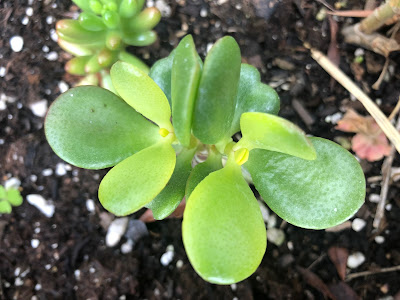
Plan for more wet weather during first week of winter

|
|
Succulents and fleshy-stemmed perennials are
susceptible to frost damage. Move them to
protected areas or cover them when temperatures
drop near freezing. (Photo: Kathy Morrison)
|
Damp: That’s the best way to describe this week in Sacramento. We start out foggy, then get more rain. But when that precipitation arrives and how much are still to be seen.
The Sacramento office of the National Weather Service says to expect “unsettled weather forecast across interior (Northern California) for the next week. Through Monday, expect cold temps and valley fog in the overnight and morning hours. Monday night possibly through next weekend will see widespread chances for rain and mountain snow. Plan for holiday travel delays!”
Right now, there’s a 65% chance of a rainy Christmas Eve. Overall, Sacramento could get 1 to 2 inches of rain this week if the storm front stays on its current course.
In addition, the weather service says to expect frost Sunday night and early Monday morning with overnight temperatures in the low 30s. The fog will keep daytime highs in the 40s, well below our normal of 54 degrees. Later in the week, storm clouds will keep nights warmer (above 40 degrees) but days will stay cold. Plan accordingly.
* Although the calendar says it’s time, don’t spray peach and nectarine trees during these damp conditions. Wait until we have a 72-hour window of dry weather.
* Poinsettias don’t like frost or rain; bring porch plants indoors. Inside or out, keep poinsettias in a sunny, warm location. Water thoroughly. After the holidays, feed your plants monthly so they’ll bloom again next December.
* Tuesday is the first day of winter and the shortest day of the year – a great time to plant garlic and onions for harvest in summer.
* Bare-root season begins. Plant bare-root berries, kiwifruit, grapes, artichokes, horseradish and rhubarb. Beware of soggy soil. It can rot bare-root plants.
* Mulch, water and cover tender plants to protect them during threat of frost. Succulent plants are at particular risk if temperatures drop below freezing. Make sure to remove coverings during the day.
* Brighten the holidays with winter bloomers such as amaryllis, calendulas, Iceland poppies, pansies and primroses.
* Rake and remove dead leaves and stems from dormant perennials.
* Prune non-flowering trees and shrubs while they’re dormant.
* Clean and sharpen garden tools before storing for the winter.
Comments
0 comments have been posted.Sacramento Digs Gardening to your inbox.
Sites We Like
Garden Checklist for week of July 21
Your garden needs you!
* Keep your vegetable garden watered, mulched and weeded. Water before 8 a.m. to reduce the chance of fungal infection and to conserve moisture.
* Feed vegetable plants bone meal, rock phosphate or other fertilizers high in phosphate to stimulate more blooms and fruiting. (But wait until daily high temperatures drop out of the 100s.)
* Don’t let tomatoes wilt or dry out completely. Give tomatoes a deep watering two to three times a week.
* Harvest vegetables promptly to encourage plants to produce more. Squash especially tends to grow rapidly in hot weather. Keep an eye on zucchini.
* Pinch back chrysanthemums for bushy plants and more flowers in September.
* Remove spent flowers from roses, daylilies and other bloomers as they finish flowering.
* Pinch off blooms from basil so the plant will grow more leaves.
* Cut back lavender after flowering to promote a second bloom.
* It's not too late to add a splash of color. Plant petunias, snapdragons, zinnias and marigolds.
* From seed, plant corn, pumpkins, radishes, winter squash and sunflowers.